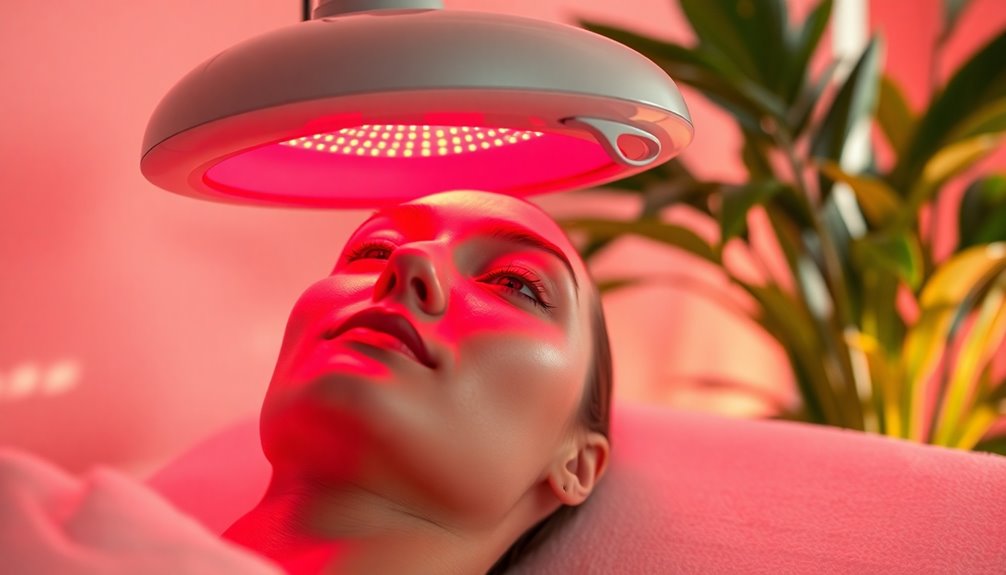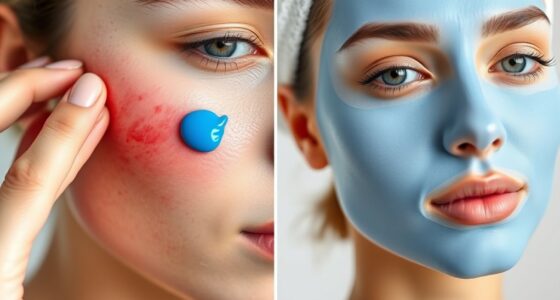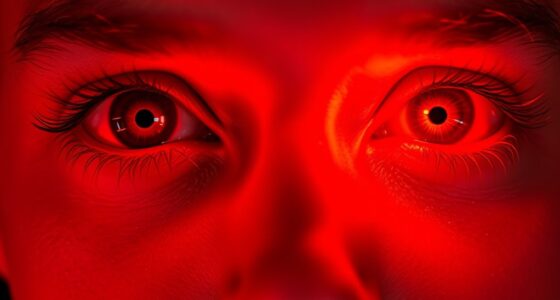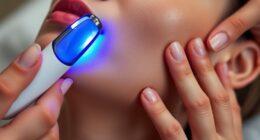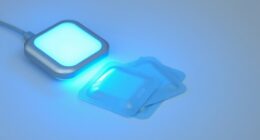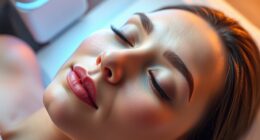Red light therapy can be safe for sensitive skin, but you must consider the potential risks. It may reduce inflammation and promote healing, but side effects like mild redness and irritation can occur. Always wear eye protection, start with shorter sessions, and monitor your skin's response. If you have pre-existing skin conditions or take certain medications, consulting a healthcare professional is a must. While many find it beneficial, outcomes can vary based on individual factors. If you want to explore how to maximize benefits while minimizing risks, there's plenty more to uncover.
Key Takeaways
- Red light therapy can aid in healing sensitive skin but may exacerbate certain conditions, necessitating individual assessment before treatment.
- Users with sensitive skin should start with shorter sessions to monitor reactions and assess tolerance effectively.
- Protective eyewear is essential during therapy to prevent headaches and eye strain from bright light exposure.
- Consultation with a dermatologist is advised for those with pre-existing skin conditions or on photosensitive medications.
- Although generally safe, potential side effects like redness and irritation must be considered for sensitive skin types.
Understanding Red Light Therapy
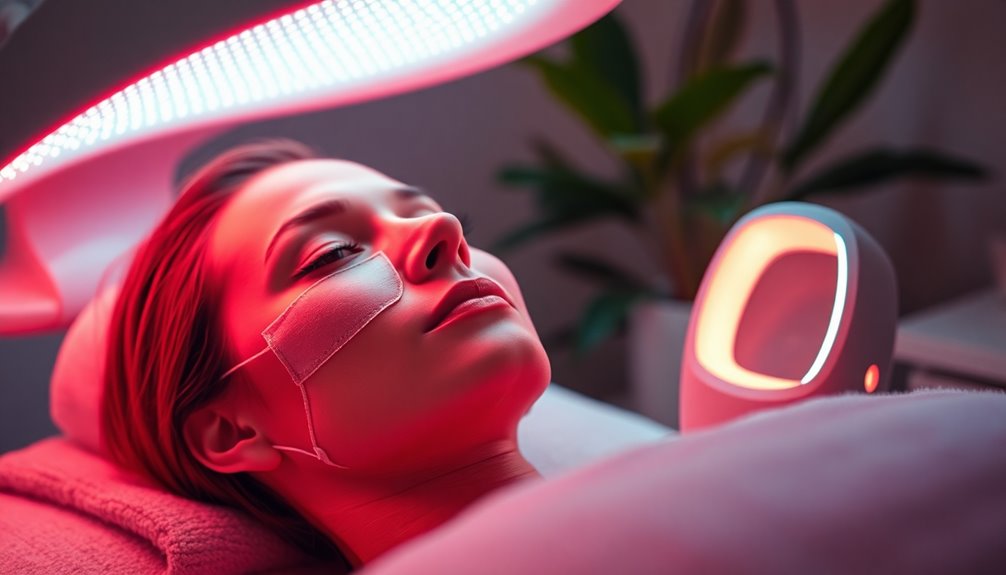
When you explore red light therapy, you'll find it harnesses specific wavelengths of light to stimulate cellular processes in your skin and body. This therapy primarily stimulates your mitochondria, boosting ATP production, which enhances cellular energy.
As ATP levels rise, you'll notice reduced inflammation and improved cellular function, promoting healing in wounds and tissue repair. Red light therapy also activates essential processes like DNA/RNA synthesis, increases blood flow, and reduces oxidative stress by allowing oxygen to attach more effectively.
The benefits are vast, including skin rejuvenation, pain relief, and even muscle recovery. Additionally, it's a non-invasive, drug-free approach that has gained FDA approval for specific uses, making it an attractive option for those seeking natural health solutions. Furthermore, it is considered a natural treatment option with minimal side effects, making it suitable for sensitive skin.
Safety Considerations for Users
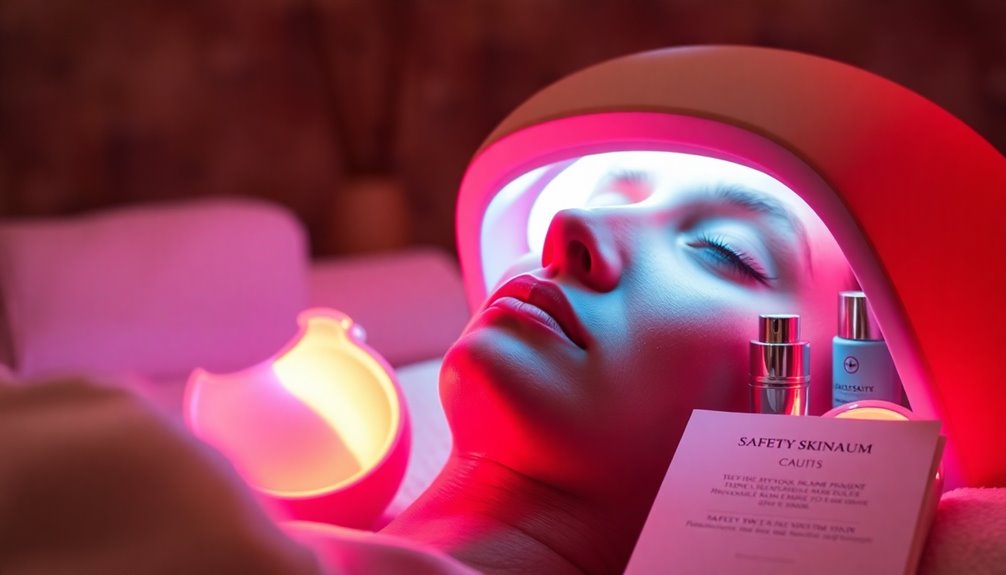
As you consider using red light therapy, it's important to be aware of safety considerations to ensure a positive experience.
First, protect your eyes; the bright light can cause damage, so wear appropriate eye protection or avoid direct exposure. Some devices automatically shut off after sessions, which adds an extra layer of safety.
For sensitive skin, you may experience mild irritation or redness, so follow treatment guidelines and monitor your skin for any reactions. Individuals with existing skin conditions should exercise caution to avoid exacerbating any issues.
Remember, red light therapy can increase your skin's sensitivity to sunlight, so use sunscreen when outdoors.
Lastly, consult a healthcare professional if you have pre-existing conditions or concerns about interactions with medications.
Prioritize safety for effective and enjoyable treatment.
Common Side Effects to Watch
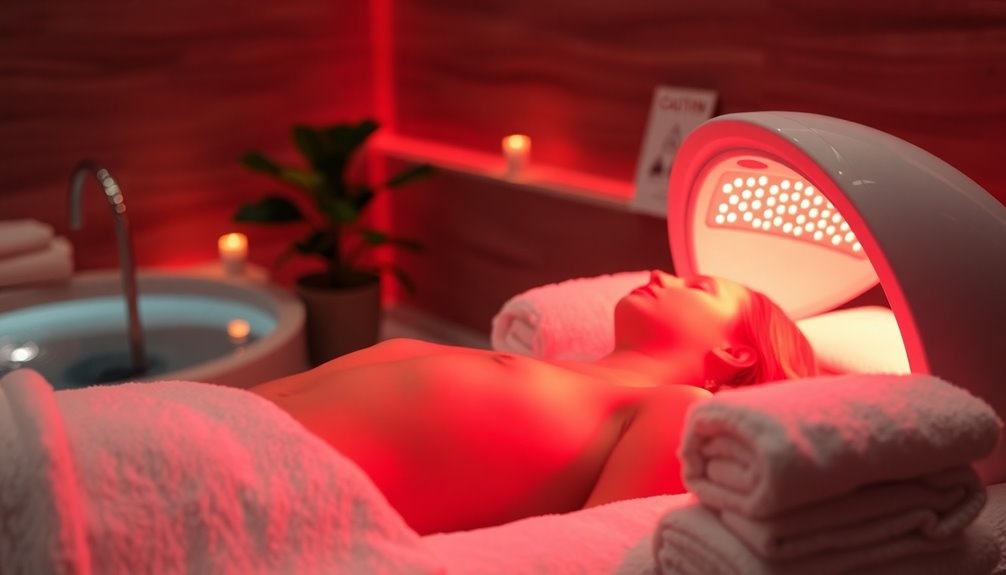
After taking safety precautions, you might want to familiarize yourself with some common side effects associated with red light therapy.
Skin irritation, like mild redness and itching, is typical, especially for sensitive skin. Blisters can occur if you don't follow usage guidelines.
If you're prone to headaches, bright light exposure may trigger discomfort, so consider wearing eye protection. The non-invasive nature of therapy can help reduce the likelihood of severe side effects, but awareness is still important.
Certain medications can increase photosensitivity, making redness and irritation more likely, so consult your healthcare provider if you're on medication.
Lastly, while some find that red light helps them sleep, others report insomnia. If you struggle with sleep, it's wise to avoid therapy before bedtime.
Always monitor your body's response to minimize any adverse effects.
Essential Precautions to Take
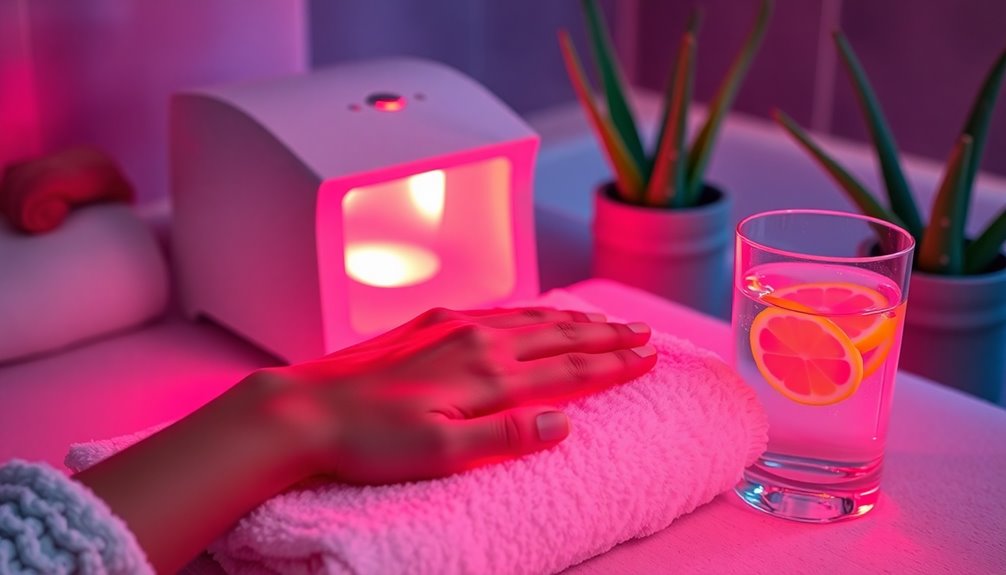
To ensure a safe and effective red light therapy experience, it's crucial to take essential precautions.
Always wear eye protection to prevent discomfort or damage during treatments. Keep the device at the recommended distance—usually 6 to 12 inches—from your skin to avoid overheating or insufficient light absorption. This optimal distance is important for maximizing light penetration and therapeutic benefits.
Start with shorter sessions and gradually increase the duration as your skin adapts. Pay close attention to any reactions; if irritation occurs, adjust your treatment accordingly.
Cleanse your skin gently before each session and avoid aggressive exfoliants. After therapy, maintain your regular skincare routine and protect your skin from excessive sunlight.
Lastly, always follow the manufacturer's instructions for optimal results and safety.
Variability in Treatment Efficacy
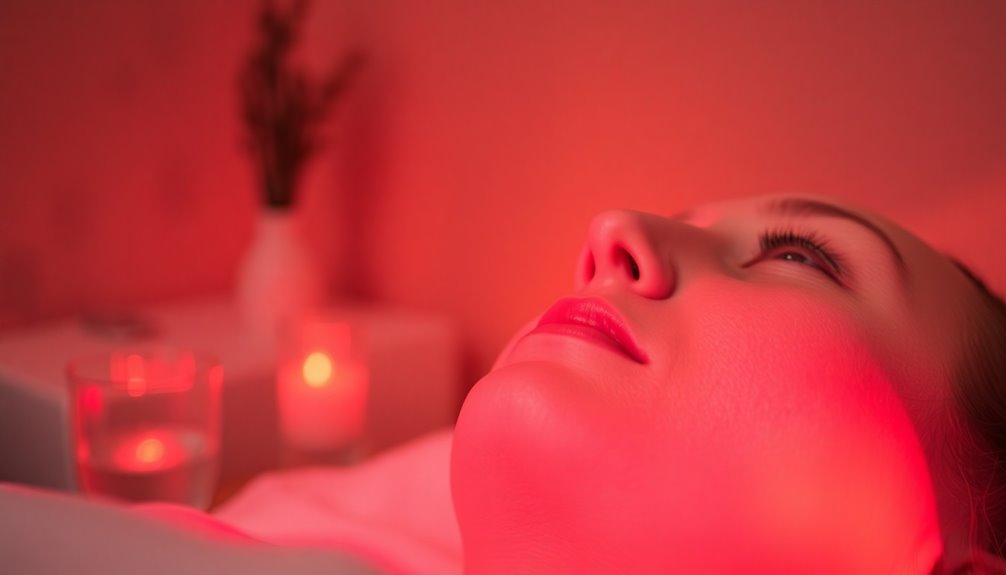
While red light therapy offers potential benefits for sensitive skin, the variability in treatment efficacy can be significant.
You might find that results differ greatly from person to person, often due to individual skin types or how well you respond to the therapy. Many studies have small sample sizes, which means they may not represent the broader population.
Additionally, the type of device you use, its intensity, and treatment duration can all play a role in how effective the therapy is for you. Stimulating collagen and elastin production through red light therapy can enhance the overall effectiveness, making it particularly beneficial for those with sensitive skin.
Combining red light with other treatments, like blue light therapy, can also affect outcomes.
Therefore, it's essential to approach red light therapy with realistic expectations and consider professional guidance for optimal results.
Impact on Medical Conditions
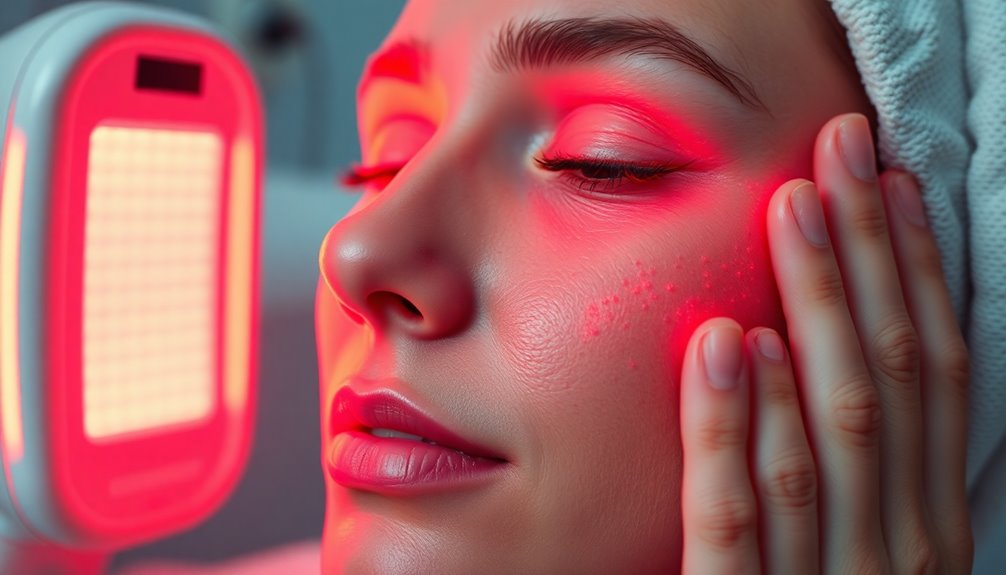
Red light therapy not only varies in its efficacy for individuals but also shows promise in treating specific medical conditions. For instance, it can help manage acne by reducing inflammation and sebum production. Studies indicate it's effective, especially when combined with other treatments.
Similarly, RLT shows potential for psoriasis by promoting healing and reducing inflammation, though more research is needed. RLT increases circulation, which can further aid in the healing process.
Additionally, it may aid in pain management, particularly for conditions like temporomandibular dysfunction and rheumatoid arthritis, thanks to its ability to stimulate blood vessel formation.
Lastly, RLT can stimulate hair growth, particularly for androgenic alopecia. However, it's essential to consult a doctor before starting RLT, especially if you have sensitive skin or a history of skin cancer.
Long-term Effects on Skin
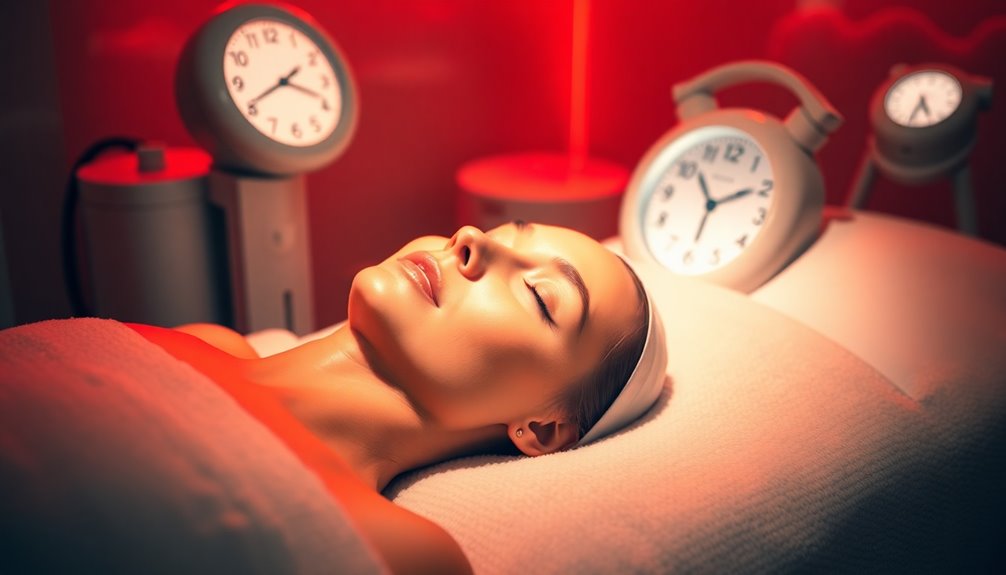
When considering long-term effects on your skin, red light therapy offers promising benefits that can enhance your skin's overall health. This therapy stimulates collagen and elastin production, helping maintain your skin's firmness and smoothness over time. Improved circulation brings vital oxygen and nutrients, supporting skin regeneration and repair. While some users may experience mild redness or irritation, these side effects are generally temporary and manageable. To minimize risks, follow usage guidelines and start with shorter sessions. Consistent use, ideally 3-5 times a week, is essential for optimal results. Exceeding 30 minutes may lead to irritation, so it's crucial to monitor your session lengths. If you have sensitive skin or specific conditions, consulting a dermatologist can provide personalized guidance to ensure you safely enjoy the long-term benefits of red light therapy.
Benefits of Professional Treatments

If you're looking to maximize the effects of red light therapy, opting for professional treatments can offer significant advantages. You'll benefit from enhanced efficacy due to higher light intensity and customized treatment plans tailored to your specific skin concerns. Professionals monitor the process, ensuring safety and minimizing risks. They can also combine therapies, like Botox or microneedling, for improved results while reducing downtime from other procedures. With advanced technology and high-quality devices, you'll receive the best care possible. Additionally, professional settings often provide more powerful results compared to at-home devices. Regular check-ups and educational support will keep you informed throughout your journey, helping you maintain the benefits of the treatment.
Making Informed Decisions
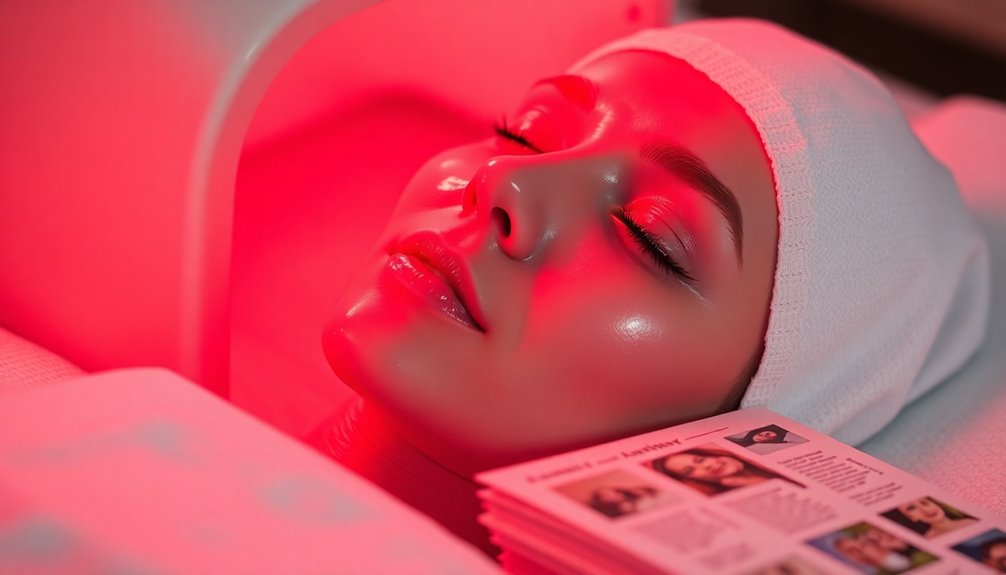
Making informed decisions about red light therapy is crucial, especially for those with sensitive skin. You should understand common side effects like skin irritation, headaches, and eye strain. Always wear protective eyewear to safeguard your eyes.
Start with shorter sessions to assess your skin's reaction, and maintain a consistent distance from the light source. Consulting a dermatologist is vital, particularly if you're on medications that increase photosensitivity.
Be cautious if you have specific skin conditions, as red light therapy may exacerbate them. Remember, while FDA-cleared devices are considered safe, their long-term effects aren't fully known. Effective for specific conditions, red light therapy may offer benefits for some individuals, but it's important to ensure it aligns with your skin type and overall health.
It’s wise to approach red light therapy thoughtfully, ensuring it aligns with your skin type and overall health. Consulting with a skincare professional can help you tailor treatments specifically to your needs. By understanding the potential red light therapy benefits for skin, you can maximize its effects while minimizing any risks. Additionally, it’s important to set realistic expectations, as results may vary from person to person based on individual skin conditions and treatment frequency.
Frequently Asked Questions
Can Red Light Therapy Be Used During Pregnancy?
Yes, you can use red light therapy during pregnancy, as it's considered safe and non-invasive.
It may help manage pain, reduce inflammation, and improve your skin health. While there's limited research, existing studies show no significant adverse effects for pregnant individuals.
Just make sure to use it under professional supervision, follow proper precautions, and protect your eyes during treatment.
Always consult your healthcare provider for personalized advice before starting any therapy.
How Often Should I Use Red Light Therapy for Sensitive Skin?
"Slow and steady wins the race!"
When using red light therapy, start with 10-minute sessions a couple of times a week, then gradually increase the duration as your skin gets used to it.
Pay attention to how your skin responds; if it gets red or tight, adjust accordingly.
Generally, aim for 3-5 sessions weekly, and always apply moisturizer afterward to keep irritation at bay.
Consult a doctor for personalized advice based on your skin's sensitivity.
Is There an Age Limit for Using Red Light Therapy?
Yes, there's an age limit for using red light therapy.
It's generally recommended for individuals aged 13 and over, but teens should hold off on anti-aging treatments until their early 20s.
If you're under 18, it's best to use blue light therapy for acne under medical supervision.
Always consult with a healthcare professional to ensure it's safe for you, especially if you have any pre-existing conditions or concerns.
What Types of Devices Are Best for Sensitive Skin?
Did you know that about 50% of people experience skin sensitivity at some point?
When considering devices for sensitive skin, opt for FDA-cleared options, as they've been rigorously tested for safety.
Look for devices with adjustable intensity, allowing you to tailor sessions to your comfort level.
Also, consider those with built-in safety features to monitor your skin's response.
These choices help minimize irritation while effectively caring for your skin.
Can I Use Red Light Therapy on Broken Skin?
You can use red light therapy on broken skin, as it may help reduce inflammation and accelerate healing.
Just make sure to follow the manufacturer's guidelines to minimize any risks.
Keep an eye out for skin irritation, and consult a dermatologist if you have any concerns or underlying conditions.
Conclusion
So, you're considering red light therapy for your sensitive skin, huh? It's almost like asking if jumping into a pool of ice water is refreshing—exciting but risky. While it can offer benefits, remember that your skin's sensitivity might not appreciate the bright lights. You could end up with more than just a glow; it's essential to weigh the pros and cons carefully. After all, who doesn't love a little extra redness, right? Just be smart about it!
